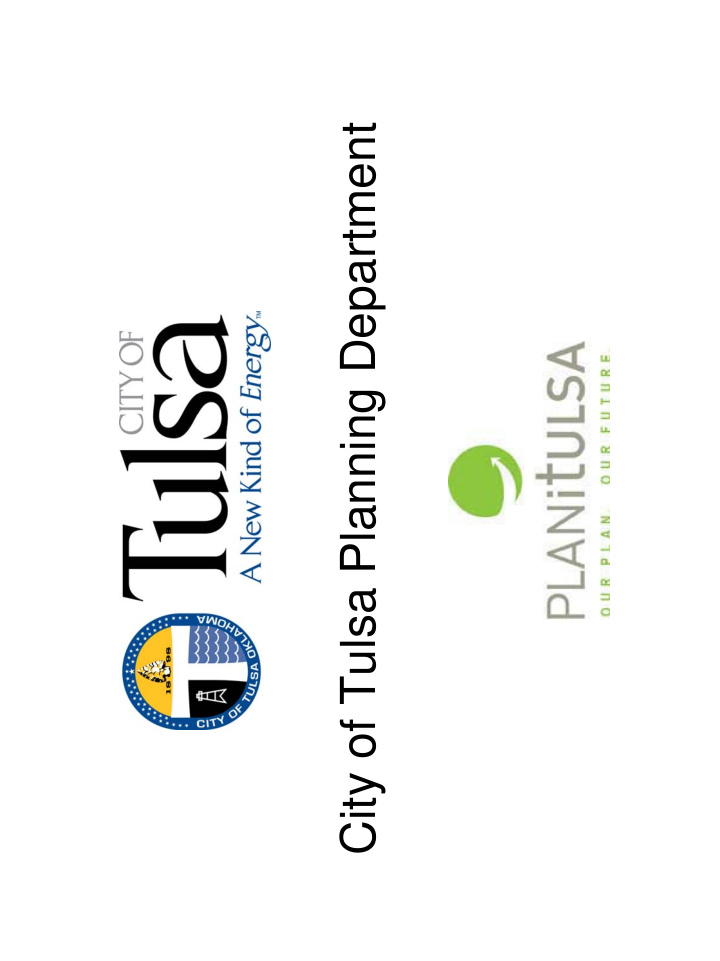



City of Tulsa Planning Department
Information Council Requested • History of Planning Department • Staffing: Roles and Responsibilities • Current Budget • How Planning Department interacts with TMAPC/INCOG
HISTORY • 1953 – Tulsa Metropolitan Area Planning Commission (TMAPC) established through state legislation. 1. Authorized City-County Planning 2. Separate entity from either government 3. Commissioners appointed by Mayor and County Commissioners 4. Operated Independently of elected officials and hired own director and staff
1960’s PLANNING • TMAPC • Tulsa Chamber of Commerce • Community Development (Office of the Mayor) • Tulsa Urban Renewal Authority
KEY INFLUENCES 1. Federal Government was sending millions of dollars to cities across the country • Model Cities Program (Pools & Recreation Centers) • Water Treatment Facilities • Roads, Bridges, Highways 2. Out of the federal government’s need to see coordination of these funds at a regional level, it established regional council of governments (COGs) to plan for the use and implementation of these funds. • 1967 INCOG was created 3.TMAPC Developed a comprehensive land use plan for the city/county
1970’s KEY INFLUENCES • Federal Government still played a significant role in cities and planning with major funding through: Urban Planning Assistance Program known as the “701” (section 701 of the Housing Act) Categorical Grants (urban renewal, water and sewer, parks grants) were replaced by CDBG (Tulsa recv’d in the $10-12 million range)
1970’s PLANNING 1972 – 1978 • Vision 2000 – New comprehensive land use plan created (Mayor Robert LaFortune) 3 Growth Policies Considered: • Balanced Growth • Satellite Nodes • Existing Trend
1980’s PLANNING • Vision 2000 Implementation (Mayor Inhofe) – Existing Trend – Satellite node approach – Current Planning (TMAPC and Board of Adjustments staff, zoning, platting, subdivision regulations) was moved to INCOG – Tulsa Urban Renewal Authority (TDA) staff were brought into the city. – Workforce was brought into the City under City Development • Federal funding for regional planning and public facilities was significantly reduced Resulted in loss of long range planning positions at INCOG and funding that has not been replaced either at INCOG or within the city
1980’s PLANNING • 1984 – The Department of City Development is re-organized (Mayor Terry Young) • Planning staff numbered 13 • Funded by Federal grants and general revenue funds Responsibilities: Planning and Research Community Development (CDBG) planning and implementation through TDA Real Estate Workforce/Job Training Tulsa Area Agency on Aging
1980’s PLANNING • 1988 – Department of Urban Development Created (Mayor Rodger Randle ) • Funded by CDBG primarily with small portion of general revenue • Responsibilities: 1. Planning, oversight and implementation of Urban Renewal Areas 2. Assisting with Tax Increment Finance Districts 3. Historic Preservation 4. Limited by funding to working primarily in urban renewal areas
1990’s PLANNING • Mayor Susan Savage expanded responsibility of Planning Department to include three Infill Development Neighborhoods – Brady Village – 6 th Street Corridor – Brookside General Revenue resources were made available to accommodate this effort. While city resources grew marginally, INCOG resources continued shrinking.
2000’s PLANNING • 2001-2004 (Mayors Susan Savage and Bill LaFortune INCOG’s budget is cut an additional 20% as part of the overall city budget cuts • 2002-2006 Urban Development Department was reorganized and included as a division within Public Works Department (Mayor Bill LaFortune) Staff role and sources of funding remained the same
2000’s PLANNING • 2006 – City of Tulsa Planning Department Created (Mayor Kathy Taylor) • Funding changed from CDBG to General Revenue to allow work to be done city-wide • Analysis of other City planning departments conducted: Average size of staff was 49 but budgets were varied. 2007-2008 budget – three additional planning positions were added in anticipation of PlaniTulsa implementation INCOG houses current planning function which includes TMAPC and BOA
City of Tulsa Planning Department – fy 08 ‐ 09 13 Planning positions – 3 vacant positions Vacant Director EX-60 02310 18 Stephen Carr Senior Planner EX‐44 02310 4675‐0002 Jim Coles Theron Warlick Martha Schultz David Simmons Vacant Amanda DeCort Vacant Planner III Planner III Planner III Planner III Planner III Planner II Office Administrator I EX‐40 EX‐40 EX‐40 EX‐40 EX‐40 EX‐32 OT‐17 02310 02310 02310 02310 02310 02310 02310 4673‐0009 4673‐0010 4673‐0011 4673‐0002 4672‐0011 2174‐0060 Tynesha Jackson Office Assistant III (p/t) Edward Sharrer Kenny Rowley Tom Dapice Monty EcElroy Dennis Whitaker Vacant Shirley Goddard OT‐15 Planner II Urban Design Planner Planner I Planner I Planner II Planner I Planner I AT‐28 EX‐36 AT‐28 AT‐28 AT‐32 AT‐32 AT‐28 02310 2172‐0016 02310 02310 02310 02310 02310 02310 02310 4672‐0001 4653‐0001 4671‐0013 4671‐0012 4672‐0009 4672‐0014 4671‐0011 Fannie Warrior Office Administrator II Ot‐18 02310 2175‐0073
CURRENT BUDGET • Expenses – Personnel Services: $997,000 – Materials and Supplies: $65,100 – Other Services and Charges: $22,900 Total: $1,065,000 • Resources – General Fund (1080): $1,065,000
Planning Department’s Role Today • Small Area and Neighborhood Plans Plan with citizens for their community’s improvement to eliminate blight and strengthen the economic prosperity of neighborhoods throughout our city. • Plan for Historic Preservation Citywide and oversee five Historic preservation districts • Administration of two improvement districts • Staff the Tulsa Arts Commission • Staff the Tulsa Preservation Commission • Oversee Urban Renewal Plans • Assist visiting Urban Planner, Dr. Jack Crowley, in the development of a downtown master plan that will be coordinated with: • PlaniTulsa – Staff is responsible for the two year project to update our city’s Comprehensive Land Use Plan • Assist, through working with other departments, the implementation of the projects called for in the plans they develop and help see adopted through the TMAPC
Interface with INCOG INCOG assists the Planning Department with: • Adoption of Neighborhood Plans • Demographics/Data • Mapping and GIS information • Guidance on zoning and land use regulations that would impact neighborhood plans • Coordination with PlaniTulsa
Recommend
More recommend